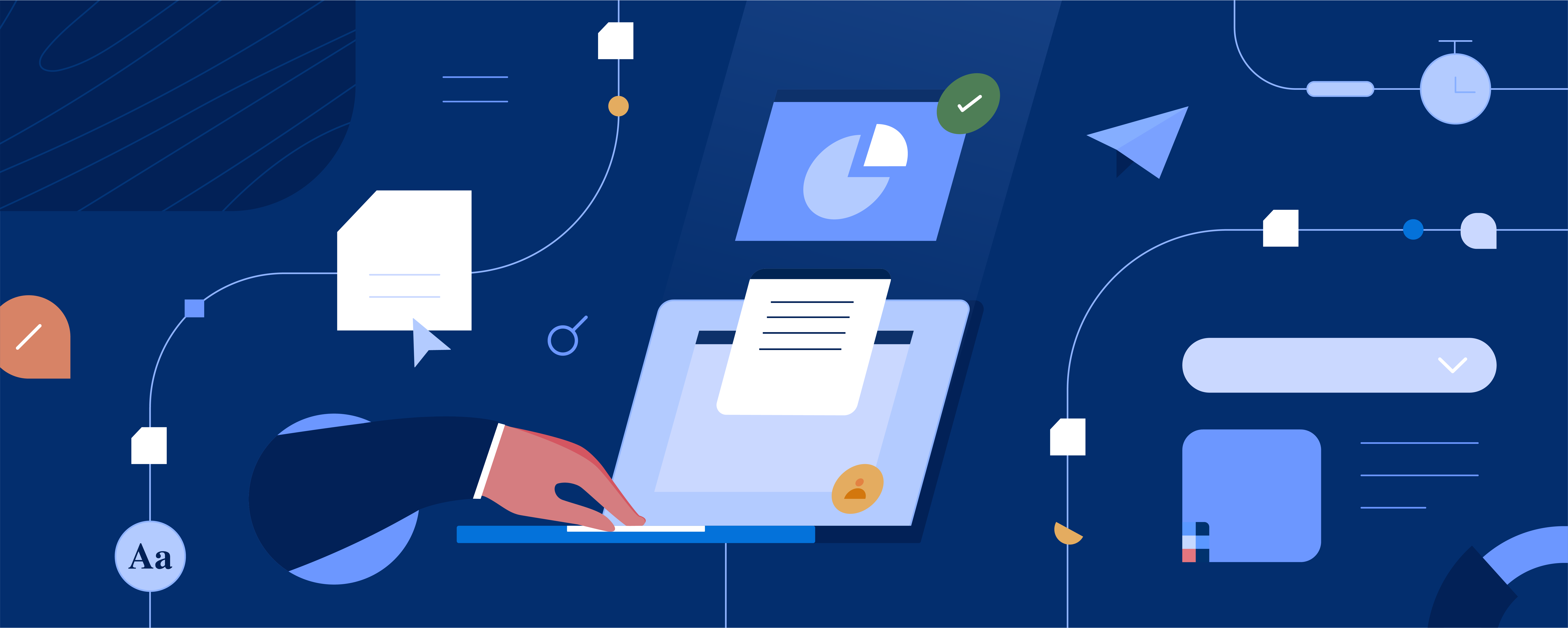Say goodbye to manual document creation with AI

How artificial intelligence and document automation have already transformed the way businesses handle documents.
If your office furniture is completely hidden by stacks of precariously-piled papers, you already know how overwhelming business documents can be.
Putting aside the environmental impact of so many printed pages, the real burden of business documents is in how long it takes to create, edit, file, send, and store them. Documents are the backbone of business growth, but they are often riddled with human errors and are too easily lost in the ether (digital or otherwise).
Digital document processing only replaces the analog nature of the work, still relying heavily on people to pull data, write copy, edit content, and review final drafts.
Enter AI document automation.
With the power of AI, teams can now automate huge portions of the document creation process, drastically reducing the time it takes to create proposals, reports, contracts, invoices, and more.
Read on for examples of how AI is transforming document generation and removing the busy work so people can get back to doing what they do best.
How does document automation use AI?
Within the context of document automation, AI is used to enhance the generation, management, and analysis of documents.
AI document automation uses tools like machine learning and natural language processing to perform tasks that have typically been done manually such as data extraction, document classification, and content analysis. This includes converting unstructured data into structured data to make it both more manageable and more trackable.
Core functionalities of AI in document automation include:
- Data extraction: Automatically identifying and extracting relevant information from documents and databases
- Document classification: Categorizing documents into predefined classes based on their content and assigned security levels
- Content analysis: Analyzing text for specific insights, sentiment, or compliance with brand standards or regulations
The Content is Everything report
2,000+ professionals on how rapid content growth is creating new risks
document automation
Top 3 benefits of using AI in document automation
- 1Increased efficiency
AI significantly reduces the need for manual input in tasks like data extraction and document classification, allowing employees to focus on more complex and strategic tasks. Automation ensures that data from documents is captured and categorized, streamlining operations and reducing bottlenecks. - 2Reduced errors
AI improves the accuracy of document processing by consistently applying the same standards across all documents, minimizing the errors typical of manual processing. AI systems can accurately identify and extract information even from poorly-formatted documents, reducing the risks associated with human error. - 3Faster processing times
AI enables real-time processing of documents. This not only speeds up workflows but also facilitates quicker decision-making and improves response times to customer inquiries and internal requests.
5 top use cases for intelligent document automation
Despite all the attention it’s getting, AI is still an emerging technology and it’s still evolving rapidly. Sometimes the best way to understand its impact is to see examples of how it is used in various industries.
Finance: Automating invoice processing and approval
By using AI-powered systems, finance teams can automatically extract data from invoices such as vendor details, amounts, and payment terms. These systems integrate seamlessly into approval workflows, where AI algorithms help in verifying invoice accuracy against purchase orders and flag discrepancies for human review. This not only speeds up the approval process but also reduces errors associated with manual data entry and invoice management, leading to faster turnaround times and improved compliance with financial policies.

Banking & Insurance: Customer onboarding with AI-powered document review
In the banking and insurance industries, customer onboarding is significantly enhanced by AI-driven document automation. AI technologies enable the extraction of customer data from identity documents, financial statements, and application forms, facilitating quick verification and risk assessment. This process ensures that all necessary documentation is complete and compliant with regulatory standards, drastically and speeding up onboarding processes.

Consulting: Proposal automation with a consistent brand identity
In the consulting industry, intelligent document automation can streamline the creation of proposals and client presentations, speeding up the pitching process and leading to more business opportunities. Using AI can also assist with the extraction and analysis of complex data from various client documents, such as financial reports, market research, and operational data. Consultants can rapidly assimilate and interpret this information to generate insights and build detailed reports.

Legal: Contract generation and management
Legal firms can use AI-powered templates to generate contracts, using machine learning models to insert appropriate clauses based on the specifics of the engagement. AI can also perform risk analysis by reviewing contracts for compliance with legal standards and company policies, flagging any potential issues for human review.
Real Estate: Lease document automation
AI tools can automatically extract key terms such as lease start and end dates, renewal conditions, and payment clauses from a range of documents, facilitating quicker lease administration and compliance checks. This capability not only enhances operational efficiency but also ensures greater accuracy in lease management, important for both landlords and tenants in maintaining contract adherence.
Get started with Templafy document automation
Selecting a software provider for document automation can be a daunting process. Whether you’re working with Templafy’s end-to-end document generation platform or another vendor, it’s important to take a strategic approach to assess your needs and choose a solution that maximizes benefits to your organization.
1. Identify pain points
Begin by analyzing your current document processing workflows to identify areas where automation can have the most impact. Look for repetitive tasks such as data entry, document sorting, and manual compliance checks that consume excessive time and resources.
2. Evaluate needs and define your goals
Clearly define what your business aims to achieve with AI document automation. Are you looking to improve accuracy, speed up processing, reduce costs, ensure compliance, or all of the above? Understanding these goals will guide your choice of solution and help you measure success.
3. Choosing the right solution
Research various AI document automation tools available in the market, and take advantage of any free demos or trials on offer. Consider factors such as the ability to integrate seamlessly with your existing systems, the range of features offered, how easy it is to use, and scalability. Tools like Templafy offer comprehensive solutions tailored for professional environments, which can be a good starting point.
4. Security and compliance
It is crucial to choose a solution that adheres to the highest standards of data security and meets all relevant regulations in your industry. Verify that the tool complies with data protection laws such as GDPR, depending on your geographical location and sector.
Looking ahead: the future of AI in document automation
The role of AI is sure to grow across all areas of business, and especially within document generation and processing. As organizations across various industries continue to recognize the inefficiencies of manual document processing, the shift towards AI-driven solutions will continue to accelerate the transition to a fully intelligent and automated document ecosystem.
AI technologies are rapidly evolving, with advancements in machine learning, natural language processing, and data analytics enhancing their capabilities. This evolution enables AI document automation tools to handle increasingly complex tasks with greater accuracy and minimal human intervention. The future will likely see these systems becoming more adaptive, learning from interactions and improving over time, which will streamline document workflows even further.
One Forrester study found that 83% of business leaders are currently experimenting with generative AI. It’s clear that finding practical use cases for AI will become a competitive advantage, no matter which industry you operate in.
Take the next step in transforming your document management processes—schedule a demo with Templafy today and see how your organization can benefit from the future of document automation.






